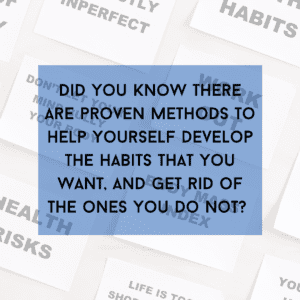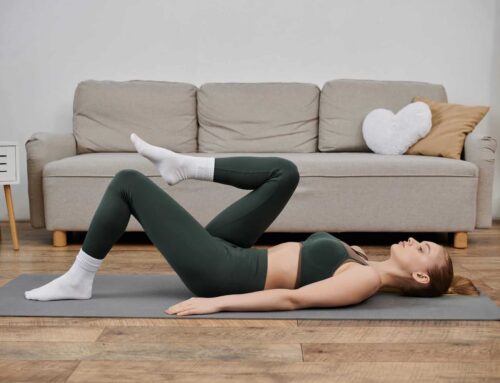Let’s talk about habit change and how to do the things that lead to a full happy life!
We often hear, I know what I am supposed to do, but I can’t get myself to do it. We know that thoughts lead to actions, which then lead to habits. If we look at these two statements, we can see that it’s thoughts that we have to actually affect in order to change the actions that we do. Which in turn changes the habits. This is where a lot of people go wrong. People are so focused on the outcome not on what needs to change within ourselves or within the processes that we have for ourselves to enable us to achieve those outcomes. People are focusing on lifestyle overhaul, but this is a shock to the system and difficult to maintain. You’re declaring a goal and changing your entire lifestyle without having the systems set up in order to help you achieve that.
Making Small Changes
We’re going to be talking about how to make small changes, small imperceptible changes that compound over time. Building a habit is enabling yourself to do something, or make a decision without having to think about it. When we break down what habits are, it’s conditioning yourself to do something to the point where you actually don’t have to think about how that decision has come about. This is important because what research has shown is that willpower is actually finite. We do not have an unending supply of willpower within ourselves for each day. What tends to happen is at the beginning of the day, when faced with the decisions, we have the willpower to start making the right choices. By the end of the day when we are tired, we don’t have the willpower to be able to make the right decision a lot of the time.
Let’s Set Ourselves Up for our Habits!
We need to set ourselves up and build habits in a way that makes it so that we do not actually have to be making these difficult decisions when our willpower is low. People set goals without building the systems to achieve them. This is one of the primary reasons that habits fail. Two of the other reasons that people fail to reach their goals is changing the wrong thing. When thinking about changing their habits, or changing habits in the wrong way. In order to actually be able to change your habits and change the systems that lead to the outcomes that you want, you have to actually focus on changing the right thing. Changing the habits in the right way. Which will enable you to build the systems in order to achieve those goals that you’re setting.
How People Typically Set Goals
The three ways that people typically set goals are outcomes focused versus process focused, versus identity focused. If we’re making an outcome based goal, we’re trying to change the outcome such as how much you weigh. They have to do with setting processes for actually being able to make those things occur.
For example, as soon as I take my work shoes off, I’m going to put my gym shoes on. That will start the process of getting ready to go to the gym, and hopefully result in you going to the gym. The third way, and the most powerful way to start creating new habits is through identity. For a lot of people, this can actually be the scariest way to start to try to change their habits. They don’t know that they’re going to like the person on the other side.
Appreciating Yourself
A lot of people believe that “I shouldn’t have to change for someone else to appreciate me”. If you don’t appreciate yourself, the only person that you are hurting with not changing is you. That is actually the only person in the world you should change for. When it comes to fear of being judged or disliked for starting a new habit or starting not to hang out with people who reinforce bad habits. You shouldn’t be worrying about what those people think.
You should be worried more about what you will think of yourself if that habit has not changed. This is going back the fact that your thoughts are what lead to actions, which are then what lead to habits. Your identity is what creates those thoughts. So, only through changing your identity, will you be able to change your thoughts. Your identity is also determined by your habits. It’s actually a loop: your identity creates your thoughts, your thoughts, create your actions, your actions, create your habits, which in turn, form your identity and your identity then creates your thoughts by changing what you do. You change who you are.
What is the habit loop?
When you’re building habits, the habit loop is the queue followed by the craving. Followed by the response. Which is followed by the reward. If we take each of these and break it down, we’re trying to create a good habit, we want to set our environment up to have obvious cues. The habits with the most cues are often the habits that are reinforced the easiest. We want to make the reward attractive. Joining a group that supports positive decisions with whatever habit you’re trying to achieve would make it very attractive to be able to do that habit. We all crave the social approval of the group that we have elected to be a part of.
You want to make your response the thing that you have to do in response to that queue easy. At the beginning, you want your response to take less than two minutes to accomplish. That’s going to give you the easiest meaningful way to actually grasp on and make this habit change. Then reward the first three things here cue craving and response. These are the things that make it so that you’ll do the behavior this time. Making the reward satisfying is what you need to do in order to reinforce that you will want to do that behavior next time.
Let’s Talk About Bad Habits
If we’re talking about bad habits. How do you break bad habits? If we’re talking about cues, we want to make them invisible. Hide them set up your environment, so that you don’t have those cues.
The First Step to Change your Habits:
Let’s say you like making a drink for yourself every night when you get home from work. This is the habit that you’re trying to break, but you keep your alcohol out on the kitchen counter. You start to notice, when you get home, that although you have good intentions, you see it. That little voice in the back of your head starts to say, this could be the one day that I break that X, that won’t be such a bad deal. Then if you notice that that starts to happen again and again, you have now found your cue. Which is in itself a big success! What your next task to do is, is to remove that cue from your environment. This way you never see it. So, that you don’t set yourself up for failure, or having to use willpower. Which you likely don’t have any more because you just spent all day breaking your back at work.
The Second Step to Change your Habits:
The second thing is to make it an attractive when we’re talking about craving. For example, having an accountability partner. You have to report to them each time that you actually don’t complete the habit, this is one way to make it unattractive. Another way to make a bad habit unattractive is to list out all the benefits of avoiding that habit. Keep that list in your pocket for a month. Every time you feel yourself wanting to do that habit, take that list out and read all the benefits that you could actually achieve in this moment. By avoiding that habit.
The Third Step to change your Habits:
The third thing to do is to make it difficult. Make it difficult to accomplish that habit. So that you have to do another undesirable task. Or you put time in the way of you having to make that decision and engage in that habit. The last part is to make it unsatisfying. When you make it unsatisfying, you make it again so that you have to report to a group perhaps when you haven’t been able to avoid that habit. So again, these are things that help you to set up your environment to create better habits. This way you can say yes, when you ask “does this behavior help me become the type of person I wish to be”?
For Example of How Habit Creates Identity:
Here is an example of two people who are trying to quit smoking. You ask the first person “Hey, would you like a cigarette?” And one of them says, “No, thanks. I’m trying to quit”. And you ask person to and their response is slightly different. They say “No thanks. I do not smoke”. The second response is an identity based response. The first response, the person is still holding on to the identity that they are a smoker. However, they are in the process of trying to quit.
By observing your own language and behavior and thought process, you can start to identify the identity that you have. If it is your identity that you wish to change, so that you can have better thoughts and actions and habits. Then you must start by figuring out what the identity that you currently hold as true is. Start using vocabulary and thought patterns that reinforce what that person or a person with those habits, actions and behaviors would do.
Developing A Habit Plan For YOU
You can develop a habit plan to help you achieve this. For example, when blank occurs, I will do blank. When I get home from work, I will change into my gym clothes, right? There’s that sample again, when I get home from work, I will walk the dog instead of pouring myself a drink. You want to construct this in a way that you’re saying I will do this behavior at this time at this location. That way, you have two different cues. The first cue is the time.
The second cue is the location by inserting the behavior. If you’ve done a good job, making that behavior or your response to that cue easy such as just changing into your gym clothes. You get the reward and satisfaction of putting that X on the calendar to make it your 15th day in a row without missing an X, then you’ll find yourself on your way to creating good habits.
The last key here is to reflect and review. You want to establish time and put it on the calendar to where you’re going to perform an honest self assessment of how you’re doing. It could be as simple as saying pass or fail. If it’s fail, then you want to investigate how this has come about in the first place. Start looking back at why it was challenging to change these habits? Did you change the wrong thing? Has the habits been changed in the wrong way? Were you focused on the outcome you wanted? Have you been focusing on changing your identity? And if you haven’t, is there a fear within that fear of what happens when you succeed? Who will you be?
Let’s Review:
At the end of the day, it is our habits that determine who we ultimately become in the picture of health and wellness. When we eat too much. We don’t exercise or move enough. If we aren’t getting enough sleep. When we drink too much. When we don’t have enough of a social life. These are the things that affect us emotionally, spiritually, physically. Over the long run, build us into people who we do not appreciate that we have become.
So when it comes to living an active healthy lifestyle, where you can avoid all sorts of Orthopedic or various other types of surgical intervention that would be otherwise. A solution to a deep problem that has been created by your habits, figuring out the thoughts and the actions and the habits and the cues and the cravings and the responses and the rewards is hands down some of the best time that you could ever spend working on yourself. At the end of the day, if you can set yourself up so that you don’t have to think about those things, then you can use your decision making power and your willpower to actually be making bigger decisions of how you get to the next level in your life.






